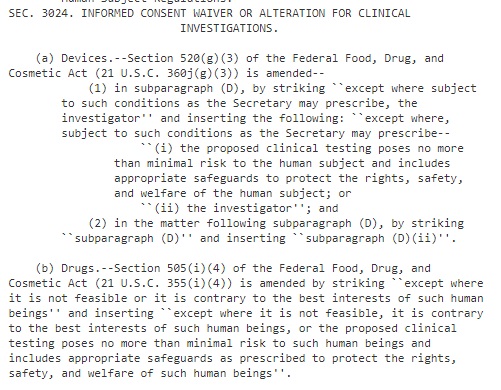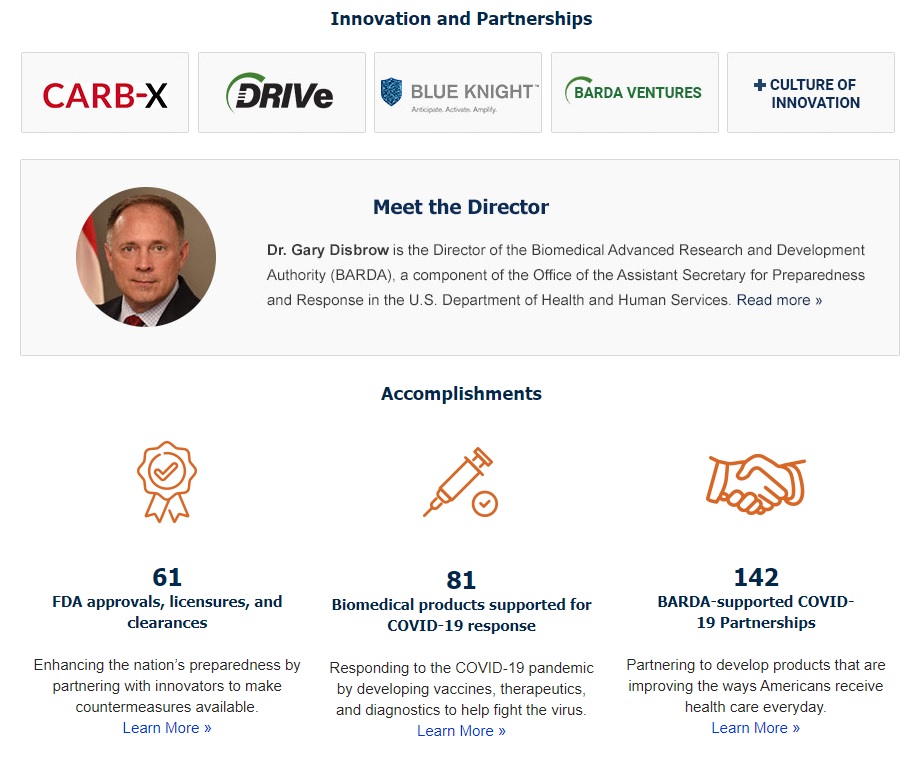Karen Kingston pointed this out in the Act: “Sec. 3024. Informed consent waiver or alteration for clinical investigations.”

Section 3024 of HR 34, 114th Congress (2015-2016): 21st Century Cures Act
SEC. 3024. INFORMED CONSENT WAIVER OR ALTERATION FOR CLINICAL INVESTIGATIONS.
(a) Devices.–Section 520(g)(3) of the Federal Food, Drug, and Cosmetic Act (21 U.S.C. 360j(g)(3)) is amended–
(1) in subparagraph (D), by striking “except where subject to such conditions as the Secretary may prescribe, the investigator” and inserting the following: “except where, subject to such conditions as the Secretary may prescribe–
“(i) the proposed clinical testing poses no more than minimal risk to the human subject and includes appropriate safeguards to protect the rights, safety, and welfare of the human subject; or
“(ii) the investigator”; and
(2) in the matter following subparagraph (D), by striking “subparagraph (D)” and inserting “subparagraph (D)(ii)”.
(b) Drugs.–Section 505(i)(4) of the Federal Food, Drug, and Cosmetic Act (21 U.S.C. 355(i)(4)) is amended by striking “except where it is not feasible or it is contrary to the best interests of such human beings” and inserting “except where it is not feasible1, it is contrary to the best interests of such human beings2, or the proposed clinical testing poses no more than minimal risk to such human beings and includes appropriate safeguards as prescribed to protect the rights, safety, and welfare of such human beings3”.
- Perhaps this would apply when the drug is still in testing?
- In other words, if the FDA secretary does not think you need to know something about a drug in testing, it will not be part of the informed consent document you will receive and be asked to sign.
- If the drug is still in testing, how would they know that it poses no more than minimal risk? Is this really for them to decide?
While looking through the text of the 21st Century Cures Act, I noticed the following: “Sec. 3093. Encouraging vaccine innovation.” This could be an indication that the people who put this legislation together knew that an innovative vaccine was coming.
SEC. 3093. <<NOTE: 42 USC 300aa-2 note.>> ENCOURAGING VACCINE INNOVATION.
(a) Vaccine Meetings.–The Director of the Centers for Disease Control and Prevention shall ensure that appropriate staff within the relevant centers and divisions of the Office of Infectious Diseases, and others, as appropriate, coordinate with respect to the public health needs, epidemiology, and program planning and implementation considerations related to immunization, including with regard to meetings with stakeholders related to such topics.
(b) Report on Vaccine Innovation.–
(1) In general.–Not later than 1 year after the date of enactment of this Act, the Secretary of Health and Human Services (referred to in this section as the “Secretary”), in collaboration with appropriate agencies or offices within the Department of Health and Human Services, including the National Institutes of Health, the Centers for Disease Control and Prevention, the Food and Drug Administration, and the Biomedical Advanced Research and Development Authority4, shall submit to the Committee on Health, Education, Labor, and Pensions of the Senate and the Committee on Energy and Commerce of the House of Representatives, and post publicly on the Internet website of the Department of Health and Human Services, a report on ways to promote innovation in the development of vaccines that minimize the burden of infectious disease.
(2) Contents.–The report described in paragraph (1) shall review the current status of vaccine development and, as appropriate–
(A) consider the optimal process to determine which vaccines would be beneficial to public health and how information on such vaccines is disseminated to key stakeholders;
(B) examine and identify whether obstacles exist that inhibit the development of beneficial vaccines; and
(C) make recommendations about how best to remove any obstacles identified under subparagraph (B) in order to promote and incentivize vaccine innovation and development.
(3) Consultation.–In preparing the report under this subsection, the Secretary may consult with–
(A) representatives of relevant Federal agencies and departments, including the Department of Defense and the Department of Veterans Affairs;
(B) academic researchers;
(C) developers and manufacturers of vaccines;
(D) medical and public health practitioners;
(E) representatives of patient, policy, and advocacy organizations; and
(F) representatives of other entities, as the Secretary determines appropriate.
(c) Updates Related to Maternal Immunization.–
(1) Additional vaccines.–Section 2114(e) of the Public Health Service Act (42 U.S.C. 300aa-14(e)) is amended by adding at the end the following:
“(3) Vaccines recommended for use in pregnant women.–The Secretary shall revise the Vaccine Injury Table included in subsection (a), through the process described in subsection (c), to include vaccines recommended by the Centers for Disease Control and Prevention for routine administration in pregnant women and the information described in subparagraphs (B) and (C) of paragraph (2) with respect to such vaccines.”.
(2) Petition content.–Section 2111 of the Public Health Service Act (42 U.S.C. 300aa-11) is amended by adding at the end the following:
“(f) Maternal Immunization.–
“(1) In general.–Notwithstanding any other provision of law, for purposes of this subtitle, both a woman who received a covered vaccine while pregnant and any child who was in utero at the time such woman received the vaccine shall be considered persons to whom the covered vaccine was administered and persons who received the covered vaccine.
“(2) Definition.–As used in this subsection, the term `child’ shall have the meaning given that term by subsections (a) and (b) of section 8 of title 1, United States Code, except that, for purposes of this subsection, such section 8 shall be applied as if the term `include’ in subsection (a) of such section were replaced with the term `mean’.”.
(3) Petitioners.–Section 2111(b)(2) of the Public Health Service Act (42 U.S.C. 300aa-11(b)(2)) is amended by adding “A covered vaccine administered to a pregnant woman shall constitute more than one administration, one to the mother and one to each child (as such term is defined in subsection (f)(2)) who was in utero at the time such woman was administered the vaccine.” at the end.
4. The Biomedical Advanced Research and Development Authority (BARDA) has been busy with COVID innovation.

Sources:
- December 13, 2016. Suzanne Bonamici. “H.R.34 – 114th Congress (2015-2016): 21st Century Cures Act.” Legislation. 2015/2016.

https://www.congress.gov/bill/114th-congress/house-bill/34.
Government.
This is the legislation that Karen Kingston cited. It would appear that she misstated its name in the video, but this is it. - January 31, 2020. “21st Century Cures Act.” US Food & Drug Administration.

https://www.fda.gov/regulatory-information/selected-amendments-fdc-act/21st-century-cures-act.
Food & Drug Administration. - October 8, 2021. Stew Peters with Karen Kingston. “RECEIPTS: DoD Joint Artificial Intelligence Center Monitoring Vaxx Deaths!” Red Voice Media, The Stew Peters Show. Runtime of embedded video: 8:31.


https://www.redvoicemedia.com/video/2021/10/receipts-dod-joint-artificial-intelligence-center-monitoring-vaxx-deaths/.
News, Video.
Karen Kingston validates Cyrus Parsa’s information with a data trail. - “Biomedical Advanced Research and Development Authority.” Public Health Emergency.

https://www.phe.gov/about/barda/Pages/default.aspx.
Government.